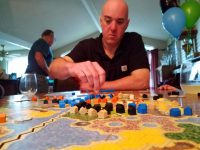 Logan got Kingdom Builder for Christmas and a few days later I discovered it was available on my phone. I’ve been playing it since then. A lot.
Logan got Kingdom Builder for Christmas and a few days later I discovered it was available on my phone. I’ve been playing it since then. A lot.
Whenever we head to Wil Wheaton’s Table Top Games videos on YouTube to see a video of them playing it. They have an episode for Kingdom Builder and it’s a good way to understand what the game is about. It’s a deep strategy game with very simple rules. There’s some luck based on what type of resource you draw each turn, but the game is mostly skill.
I couldn’t find a nice strategy guide for the game so I thought I’d make an attempt. I’m by no means an expert, but I’ve played through a few hundred matches so I figure I can at least get one started.
- Before you put down any pieces, come up with a strategy for your game.
- What kinds of scoring cards are out? Which ones will give you the most points? Some cards like Knights are worth a lot of points and others like Citizens are worth less. If, for example, there aren’t any high scoring cards out, then you might want to focus more on building next to castles. If the game involves Farmers, you need to figure out how to get your pieces into all four quadrants.
- What special tiles are in play? If there is a Hermit card turned up and you don’t play on the Horse tile, you’re probably not going to win. There are other good matches too. If Merchants are in play, try to grab the Boat tile if it is available. The Watchtower tile is a great one if you’re using either Discoverer or Knight cards.
- Usually it’s hard to focus on all three scoring cards at once, so pick the two highest value ones and focus on those first. Get points with the third card when you’re stuck with the first two toward the end of the game.
- Be careful where you place your tile. That sounds obvious, but those first two or three turns can make or break your game. For example, let’s say that you have a Farmers card and you need to get a piece in all four quadrants. If your first place touches all of the different land types, then it’s going to be very hard to get to all four quadrants. But if you can play those first pieces, get a tile, and only touch one resource type, you have a good chance of being able to play somewhere else on your next turn. On the flip side, if you’re trying to get points with Lords or Citizens, then you might want to spread out and touch lots of different resources so that you can keep growing those settlements.
- The special location tiles come in two main categories. A winning game will probably make use of some from each category.
- Relocation: These let you move pieces to other locations after they have been played. This is useful for breaking up settlements in a Hermits game but has other value too.
- Additional pieces: These let you play more than 3 pieces in a game. It’s really hard to win a game if you still have 10 pieces left when someone else goes out.
- The value of the Horse tile cannot be understated. You can make up for a lot of mistakes with this tile and also grab a lot of extra points. If you have both tiles it’s pretty easy to travel around the board and get most/all of the castle points. The horse tile is a great first play too because if you happen to be touching the next resource card, you could play your horse tile first and hop away leaving you free to play elsewhere on the board.
- With every play, think about how many points you’re getting. Sometimes you can get 4 or 5 points with a single piece (play next to a castle next to water and/or mountains with Fisherman and/or MIners in play.) The total points in a game will vary widely by the type of cards in play (I’ve seen winning scores below 40 and above 115), but in general, you need to get at least one point for every piece. If you have to put down a piece with 0 points (or even 0.5 points), think about how you can move it somewhere else on the board with one of your relocation tiles.
- Get your own house in order first, but as you’re playing out your strategy, consider opportunities to block your opponents. For example, if they don’t have a Horse and they’re building a long row for Knights, a single piece in their way might keep them away from a lot of points. Also, in a game of Hermits, don’t leave an isolated single resource open. That’s a surefire point for someone else who draws that resource card.
- The randomness in the game stems from having to draw a terrain card at the start of every turn. You can decrease the risk by know what you’ll do with every different terrain card. They might not all be equally awesome, but hopefully you can do something with every card to get you some points.
This is one of my favorite board games. You can explain the rules to a new player in a couple minutes but it will take a lifetime to master it.
